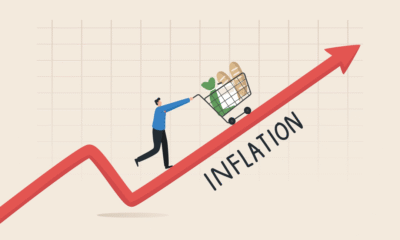Investing
Top Performing ETFs in 2025: Where Investors Are Putting Their Money

Introduction to ETFs
Exchange-Traded Funds, commonly known as ETFs, are investment funds that are traded on stock exchanges, similar to individual stocks. They are designed to track the performance of a specific index, commodity, or a collection of assets, making them an attractive option for investors seeking diversification. One of the primary advantages of ETFs is their ability to offer exposure to a varied assortment of securities under a single investment vehicle, which can significantly reduce overall portfolio risk.
ETFs work by pooling funds from multiple investors to purchase a basket of underlying assets. This structure allows investors to buy shares of the ETF, which represent ownership in the underlying assets without having to manage each individual security themselves. The ease of trading is another benefit; ETFs can be bought and sold throughout the trading day at market prices, unlike mutual funds, which only trade at the end of the trading day.
The popularity of ETFs has surged in recent years, driven by their flexibility, tax efficiency, and generally lower expense ratios compared to traditional mutual funds. Investors appreciate the transparent nature of ETFs, as they typically disclose their holdings on a daily basis, allowing investors to understand what they own at any given time. Moreover, many ETFs provide opportunities in niche markets and sectors that may be harder to invest in directly.
In addition to diversification and cost advantages, ETFs also cater to a range of investment strategies—from passive index tracking to more active, sector-focused management approaches. This versatility has made them a go-to choice for both individual and institutional investors looking to enhance their portfolios and capitalize on market opportunities. Given these attributes, ETFs are likely to remain a critical element of investment strategies in the coming years.
Why 2025 is a Key Year for Investing
As we look toward 2025, various economic factors and market trends are poised to influence investor behavior significantly. Understanding these elements is crucial for individuals looking to make informed investment choices in a rapidly evolving financial landscape. One of the most pressing considerations is the trajectory of interest rates. Following a period of sustained low rates, any shifts in central bank policies could affect borrowing costs, thereby impacting consumer spending and corporate investments. Anticipated rate hikes may shift investor appetite toward income-generating assets, such as ETFs that focus on dividend-paying sectors.
Additionally, inflation continues to be a central concern for investors. With prices fluctuating and rising in certain areas, there is an ongoing debate about the long-term sustainability of these trends. High inflation may prompt a realignment of investment strategies, as capital allocation increasingly favors sectors that historically perform well in inflationary environments, such as commodities or energy-related ETFs. Investors might also seek out funds that provide a hedge against inflation to preserve purchasing power.
Technological advancements further play a pivotal role in shaping investment portfolios. The acceleration of innovation in fields such as artificial intelligence, renewable energy, and biotechnology is creating new investment opportunities. ETFs that track specific tech-centric themes are gaining traction, directing capital into sectors anticipated to experience robust growth in coming years. As businesses adapt to these advancements, they are likely to bolster overall economic performance, enticing more investor dollars into these sectors.
Finally, geopolitical events will undoubtedly influence market sentiments. Developments regarding trade agreements, conflicts, and policy decisions can have immediate effects on global markets. Investors will closely monitor these conditions, adjusting their strategies where necessary to mitigate risks or capitalize on emerging opportunities.
Sectors Driving ETF Performance
In the landscape of exchange-traded funds (ETFs), specific sectors are anticipated to be focal points for growth and investor interest in 2025. The technology, healthcare, renewable energy, and emerging markets sectors are poised to drive significant ETF performance, supported by various economic and societal trends.
Technology continues to be a leading sector influencing ETF performance. The ongoing digital transformation accelerated by advancements in artificial intelligence, cloud computing, and cybersecurity is likely to sustain the allure of tech-focused ETFs. Investors are drawn to how these innovations enhance productivity and create efficiencies across numerous industries, rendering technology not only a safe harbor for investment but also a fertile ground for substantial returns.
Healthcare, particularly biotechnology and telehealth, is another sector projected to excel. The aftermath of the COVID-19 pandemic has intensified focus on medical innovation and healthcare accessibility, leading to increased funding and consumer interest. ETFs that invest in companies developing breakthrough therapies or leveraging telemedicine solutions are expected to perform well as demographic shifts contribute to growing healthcare needs globally.
Furthermore, renewable energy is gaining attention amid global calls for sustainable practices and decarbonization. The transition from fossil fuels to renewable energy sources is creating formidable investment opportunities. ETFs representing solar, wind, and other sustainable technologies are rapidly attracting more capital as countries commit to greener policies, providing a steadfast growth trajectory for investors committed to sustainability.
Lastly, emerging markets present a realm of untapped potential. With rapid urbanization and a burgeoning middle class, these economies show promise for high growth rates that can significantly impact ETF performance. Investors looking to diversify their portfolios often find ETFs in this sector appealing due to the opportunities to capitalize on demographic and economic trends.
Top-Performing ETFs to Watch
As investors look ahead to 2025, several Exchange-Traded Funds (ETFs) have garnered attention due to their impressive performance and strategic investment approaches. By analyzing their historical gains and potential for sustainability, one can identify viable investment opportunities. Among the noteworthy ETFs is the SPDR S&P 500 ETF Trust (SPY). This fund mirrors the S&P 500 index, making it a staple for those seeking stability and growth. Not only has SPY demonstrated consistent year-on-year returns, but it also provides diversification across various sectors, aiding risk management for investors.
Another standout is the Invesco QQQ Trust (QQQ), which tracks the Nasdaq-100 index. QQQ’s focus on large-cap technology and biotech stocks has propelled its outstanding growth, particularly as these industries expand further into everyday applications. The ETF is recognized for its aggressive capital appreciation potential and offers a promising avenue for technology-driven portfolios.
Furthermore, the Vanguard Total Stock Market ETF (VTI) is vital for exposure to the entire U.S. equity market. It encompasses small, mid, and large-cap growth and value stocks, making it an appealing choice for those looking for comprehensive market representation. With a low expense ratio, VTI remains attractive to cost-conscious investors aiming for broad diversification.
Lastly, the iShares MSCI Emerging Markets ETF (EEM) has captured investor interest by tapping into global growth potential. Emerging markets are anticipated to experience substantial economic growth in the coming years, and EEM’s ability to capitalize on this trend positions it as an attractive choice for risk-tolerant investors seeking higher returns.
In considering these top-performing ETFs for 2025, investors should evaluate the balance between potential risks and returns specific to their financial goals and risk tolerance, thereby making informed investment decisions.
Investor Sentiment and Behavior
In 2025, investor sentiment continues to be a critical factor influencing the decisions of those participating in the exchange-traded funds (ETFs) market. The dynamic nature of market volatility and the ongoing economic shifts have prompted notable changes in how investors approach their portfolios. Risk tolerance has undergone a transformation, with many investors exhibiting a cautious approach towards higher-risk assets. This shift is largely a response to recent market fluctuations, leading to a marked preference for stability and diversification within ETF holdings.
Data collected from various financial surveys indicate that a significant portion of investors are gravitating toward ETFs that emphasize low volatility and consistent performance. This trend reflects a broader apprehension towards unpredictable market conditions, as investors actively seek vehicles that can provide a safe haven during turbulent times. Consequently, ETFs that focus on defensive sectors—such as consumer staples and utilities—are experiencing increased inflows as investors prioritize steady returns over aggressive capital gains.
Additionally, the debate between active and passive management continues to influence investor behavior in the ETF space. A growing number of investors are favoring passive management strategies, considering their lower costs and the historical performance consistency offered by these investment vehicles. Passive ETFs, particularly those that track major indices, are gaining traction as they provide a simple yet effective way to garner market exposure without incurring the higher fees associated with actively managed funds. However, a subset of investors remains committed to actively managed ETFs in an effort to capitalize on market inefficiencies and pursue higher returns.
Overall, the identifiable trends in investor sentiment and behavior in 2025 highlight a decisive pivot towards more strategic investment decisions tailored to current economic realities. As the landscape of investor preferences evolves, understanding these behavioral patterns will be paramount for both seasoned and novice investors navigating the ETF market.
Impact of Technology on ETFs
The evolution of exchange-traded funds (ETFs) over the past decade has been significantly influenced by advances in technology. These developments have not only enhanced the accessibility of ETFs for retail investors but have also transformed the way investment strategies are executed. One notable advancement is the rise of robo-advisors. These platforms utilize algorithms to create and manage diversified portfolios that include ETFs, allowing investors with smaller capital to benefit from professional investment management. Robo-advisors typically analyze an individual’s risk tolerance, financial goals, and time horizon to create customized ETF portfolios, making the investment process more accessible to a broader audience.
Moreover, technology has introduced algorithm-driven trading strategies that play a pivotal role in the ETF market. High-frequency trading and quantitative analyses enable investors to identify trends and execute trades swiftly and efficiently. This technological shift has increased the liquidity of ETFs, making it easier for investors to enter and exit positions without significant impact on market prices. The integration of algorithms also allows for greater data analysis, leading to improved strategies that can adapt to the rapidly changing market conditions.
Artificial intelligence (AI) is another transformative element reshaping ETF investment processes. AI can analyze vast amounts of data far more quickly than traditional methods, providing insights that inform investment decisions. By optimizing portfolio management through machine learning techniques, AI enhances the ability to predict market movements and adjust holdings within ETF portfolios in real-time. As these technologies continue to evolve, they promise to further change the landscape of ETFs, improving efficiency and allowing for more sophisticated investment approaches.
In conclusion, the impact of technology on ETFs is profound and ongoing. As robo-advisors, algorithmic trading, and AI continue to develop, they will provide new opportunities for investors, leading to more informed and accessible investment options in the ETF space.
ESG ETFs: A Growing Trend
The rise of Environmental, Social, and Governance (ESG) ETFs has notably transformed the investment landscape in recent years. As global awareness of climate change and social issues intensifies, investors are increasingly prioritizing sustainability in their investment strategies. ESG-focused ETFs, which pool investment in companies that meet specific environmental and social criteria, have gained traction as a preferred vehicle for socially conscious investors. This trend is expected to continue through 2025 as sustainability becomes a core pillar of investment decision-making.
In 2025, the performance of ESG ETFs is projected to remain robust, driven by an increasing demand for transparency and accountability from corporations regarding their social and environmental impact. Investors are now more equipped with information through innovative data analytics, allowing them to measure corporate performance against ESG standards effectively. As a result, ESG ETFs are not just addressing ethical considerations but are also providing competitive returns, thereby attracting a broader investor base.
Moreover, many asset managers are responding to the rising interest in sustainable investing by creating new ESG-focused funds. These funds are designed to cater to various investor preferences, from those focusing on renewable energy to others prioritizing gender equality in corporate leadership. This diversification within ESG ETFs enables investors to align their portfolios with personal values while still targeting financial objectives.
Furthermore, institutional investors are increasingly supporting ESG strategies, recognizing that long-term financial performance can be closely linked to responsible corporate behavior. Consequently, this shift towards ESG investing is not merely a fleeting trend; it indicates a systemic change driving the investment community towards a more sustainable and ethical approach. As such, ESG ETFs are poised to play a pivotal role in shaping the investment strategies of tomorrow’s socially conscious investors.
Challenges and Risks of ETF Investing
Exchange-Traded Funds (ETFs) have gained significant popularity in recent years due to their perceived advantages, such as diversification and liquidity. However, like any investment vehicle, ETFs are not without challenges and risks that investors should carefully consider. Market risks remain one of the primary concerns associated with ETF investing. Since ETFs usually track an underlying index or asset, they are subject to market volatility and the inherent risks specific to the sectors or securities they represent. Thus, if the market experiences a downturn, the ETFs that track those indices will generally follow suit, leading to potential losses for investors.
Another challenge is related to liquidity issues. Although ETFs are generally known for their liquidity, this can vary significantly among different funds. For example, ETFs with lower trading volumes may have wider bid-ask spreads, which can affect the cost of entering or exiting a position. In times of market stress, liquidity can dry up even for well-known ETFs, further complicating the buying and selling process.
Additionally, investors may face the potential for tracking error. This occurs when an ETF does not perfectly replicate the performance of its benchmark index, often due to factors such as fees, management decisions, or the timing of trades. Tracking error can lead to discrepancies in expected versus actual returns and may confuse investors who are counting on precise alignment with the underlying assets.
To navigate these challenges, investors should consider several strategies. Conducting thorough research on an ETF’s underlying assets, trading volume, and expense ratios can help in making informed choices. Utilizing stop-loss orders can also help mitigate risks by protecting profits or limiting losses in volatile market conditions. By understanding these challenges and employing appropriate risk management techniques, investors can better position themselves to harness the advantages of ETF investing while managing its inherent risks.
Conclusion: Future Outlook for ETF Investors
The exchange-traded fund (ETF) market has experienced significant growth and evolution over the years, particularly as more investors seek diverse and accessible investment vehicles. As of 2025, various trends indicate that ETFs are likely to play an even more pivotal role in investment strategies. Investors are increasingly attracted to these funds due to their liquidity, tax efficiency, and cost-effectiveness. The importance of continual evaluation and adaptation cannot be overstated, especially as market conditions change.
One of the foremost considerations for investors in the coming years is the shift towards sustainable and socially responsible investing. This trend is evident in the rising popularity of ESG (Environmental, Social, and Governance) ETFs, which align with the values of a growing number of investors. As regulatory frameworks evolve and consumer preferences shift towards sustainable products, ETFs focusing on these themes are poised to attract significant capital.
Moreover, advances in technology and data analytics will continue to transform the ETF landscape. A growing appetite for innovation is prompting fund managers to develop more sophisticated ETFs that tap into emerging sectors and niche markets. This includes thematic ETFs centered on trends such as artificial intelligence, biotechnology, and renewable energy, which are expected to garner considerable interest from investors seeking long-term growth opportunities.
As we look ahead, it is essential for ETF investors to remain vigilant and informed about macroeconomic indicators, market shifts, and emerging investment themes. Regularly assessing investment strategies and adjusting portfolios in response to these factors will be crucial for navigating the evolving landscape. The future of ETFs is promising, but success will require a proactive approach and a commitment to ongoing education regarding current trends and market dynamics.
Finance & Investment
Trade Surveillance in Banking: Lessons from JPMorgan’s $348 Million Fine

Trade surveillance is a critical compliance function in banking and financial services that ensures the integrity of market activities and adherence to regulatory requirements. Effective trade monitoring helps prevent market abuses such as insider trading, front-running, and manipulation, protecting both investors and the broader financial system. Recently, JPMorgan Chase faced a substantial $348 million fine imposed by the Federal Reserve and the Office of the Comptroller of the Currency (OCC) due to inadequate trade surveillance controls. This high-profile penalty serves as a stark reminder to banks worldwide about the vital need for robust monitoring systems. Trade surveillance involves collecting and analyzing massive volumes of trading data in real time to identify suspicious behaviors or patterns that may indicate misconduct. As markets become more complex and trading volumes grow exponentially, financial institutions must invest heavily in surveillance technologies and governance frameworks to meet evolving regulatory expectations and safeguard their reputations.
The JPMorgan Case: What Went Wrong?
JPMorgan Chase’s penalty arose from several shortcomings in its trade surveillance program. Regulators found that the bank’s monitoring systems failed to adequately cover all trading venues and did not effectively analyze the full range of data needed to detect potential misconduct. Gaps in oversight allowed certain trading activities to go unchecked, increasing the risk of market abuses. Additionally, the bank’s controls were insufficient in preventing or identifying misconduct promptly, which is crucial for timely investigation and remediation. These deficiencies pointed to weaknesses in both technology infrastructure and internal governance. The case highlighted the consequences of inadequate surveillance, not only in terms of financial penalties but also reputational damage and potential loss of client trust. For financial institutions, the lesson is clear: trade surveillance cannot be an afterthought but must be a comprehensive, continuously updated program integral to daily operations.
Best Practices for Effective Trade Surveillance Systems
To avoid costly penalties and operational risks, banks need to implement trade surveillance systems that are robust, scalable, and adaptive. Best practices include integrating advanced analytics capable of processing large data sets across multiple trading platforms in real time. Machine learning and artificial intelligence technologies are increasingly being used to improve anomaly detection, reduce false positives, and provide compliance teams with actionable insights. Comprehensive surveillance programs also require strong governance frameworks that ensure clear roles, responsibilities, and accountability within the institution. Regular audits and continuous improvement cycles help identify gaps and adapt to new market practices or regulatory changes. Employee training and cultivating a compliance-oriented culture are equally important to ensure that staff understand surveillance requirements and actively support adherence. Transparency in reporting and effective communication with regulators can further enhance a bank’s ability to manage compliance risks proactively.
Technology’s Role in Enhancing Trade Surveillance
The complexity of modern financial markets demands that trade surveillance leverages cutting-edge technology solutions. Automated systems can monitor millions of trades, cross-referencing data from various sources such as order books, messaging systems, and market data feeds. AI-powered algorithms identify suspicious patterns that human monitors might miss and prioritize alerts for compliance teams to investigate. These technologies not only improve detection speed but also help reduce the burden of manual reviews, allowing staff to focus on high-risk cases. Additionally, cloud computing and big data architectures enable scalable storage and processing power essential for handling the volume and velocity of trade data. Implementing these technological advancements positions banks to meet stringent regulatory standards while maintaining operational efficiency and competitive advantage.
Strategic Takeaways for Banks and Financial Institutions
The JPMorgan fine underscores that trade surveillance is a critical area where banks cannot afford complacency. Financial institutions must treat compliance as a strategic priority, allocating sufficient resources to technology, people, and processes. Proactive investment in surveillance infrastructure not only reduces the risk of regulatory penalties but also enhances trust among clients and investors. Moreover, comprehensive trade monitoring helps detect internal control weaknesses and potential operational risks early, preventing larger issues. Institutions should conduct regular risk assessments to identify vulnerabilities and tailor surveillance parameters accordingly. Collaboration with regulators and industry groups can provide insights into emerging threats and best practices. Ultimately, integrating trade surveillance into the core of banking operations fosters a culture of integrity and resilience that benefits the institution and the financial markets as a whole.
Conclusion: Compliance as a Competitive Advantage
In conclusion, the JPMorgan Chase $348 million fine serves as a powerful cautionary tale for the banking sector, emphasizing the critical importance of effective trade surveillance. As financial markets evolve and regulatory scrutiny intensifies, banks must invest in sophisticated monitoring systems supported by advanced analytics and a strong compliance culture. Trade surveillance is not merely a regulatory obligation but a strategic tool that protects market integrity, strengthens client relationships, and mitigates operational risks. By learning from high-profile cases like JPMorgan’s, financial institutions can enhance their surveillance capabilities, avoid costly fines, and maintain their competitive edge in a complex and rapidly changing industry landscape. For banks committed to excellence, compliance and innovation must go hand in hand to build sustainable, trustworthy financial services for the future.
Economics
Asia’s Private Credit Boom: What It Means for Retail Investors

The Asia Pacific region is witnessing an extraordinary surge in private credit, transforming the financial landscape significantly. Private credit refers to direct lending to companies outside public markets, and over the last decade, this sector’s assets under management have grown from around $500 million to nearly $2 trillion. This rapid expansion is largely driven by emerging markets such as India and Australia, where businesses increasingly seek alternative financing solutions beyond traditional bank loans and public debt offerings. Historically, private credit has been dominated by institutional investors including pension funds and private equity firms. However, the landscape is evolving as retail investors gain access to this asset class through changing regulations, fintech platforms, and increased market demand. The expanding private credit market now offers retail investors an opportunity to diversify their portfolios and participate in an asset class that has demonstrated strong returns and resilience.
Why Private Credit Appeals to Retail Investors
Private credit has grown in popularity due to its potential to offer higher returns compared to traditional fixed-income investments such as government bonds or corporate debt. This is because private credit involves lending to companies with less liquidity and higher credit risk, factors that typically command a premium in yields. Retail investors often face challenges like low interest rates on savings and volatile stock markets, making private credit an attractive alternative for income generation and diversification. The growing involvement of financial giants such as JPMorgan Chase, which has recently allocated over $50 billion into the Asia Pacific private credit market, highlights the confidence that institutional investors have in the asset class. This institutional interest helps validate the opportunity for retail investors to explore private credit as part of a balanced investment strategy that supports both income goals and risk mitigation.
Regional Drivers Behind Asia’s Private Credit Boom
Asia’s private credit growth is closely tied to specific market conditions and regulatory environments within the region. In India, the tightening of banking regulations and a rise in non-performing assets have created a financing gap that private credit funds are actively filling. This has allowed companies to access capital through more flexible and tailored lending arrangements. Meanwhile, Australia’s advanced financial system and regulatory framework support a vibrant ecosystem of private credit funds and alternative lending platforms. These developments offer retail investors in these markets a variety of ways to participate in private credit. Investors can access this asset class through private debt mutual funds, alternative asset management platforms, and regulated digital lending marketplaces. Nevertheless, understanding the regulatory landscape and investment vehicle structures is critical to ensuring compliance and aligning investments with personal risk tolerance.
Key Risks and Considerations for Retail Investors
While private credit offers appealing opportunities, it is important for retail investors to be aware of its unique risks and challenges. Unlike publicly traded securities, private credit investments often involve longer lock-in periods during which liquidity is limited. This means investors may not be able to access their funds quickly, which could be a disadvantage for those requiring flexible cash flow. Additionally, private credit carries credit risk, meaning the possibility of borrower default can impact returns. Transparency is typically lower in private credit compared to public markets, so investors should diligently assess the quality and track record of the fund managers or platforms offering these investments. Understanding the underlying borrower profiles and loan terms is essential to mitigate potential losses. Fees can also be higher due to the complexity involved in underwriting and managing private loans. For these reasons, retail investors should perform comprehensive due diligence, seek professional advice, and only allocate a suitable portion of their portfolios to private credit.
The Role of Education and Professional Guidance
Given the complexities of private credit investing, education and expert advice are indispensable for retail investors. Keeping abreast of regulatory changes, market trends, and emerging opportunities is vital to making informed decisions. Awareness of how alternative investments are regulated in different countries within Asia Pacific helps avoid compliance issues and ensures access to legitimate investment products. Many financial advisors recommend that retail investors allocate a moderate portion of their investment portfolios to private credit as a way to enhance income and reduce correlation with traditional asset classes. However, this allocation should reflect an investor’s financial goals, risk appetite, and liquidity needs. Partnering with experienced fund managers or licensed investment platforms can provide additional safeguards and insights into this relatively complex market.
Supporting Regional Economic Growth Through Investment
Investing in private credit is not only about financial returns; it also plays an important role in supporting economic growth in Asia Pacific. Private credit financing helps small and medium enterprises (SMEs), startups, and infrastructure projects secure the capital they need to expand operations, innovate, and create jobs. Retail investors who participate in this market contribute indirectly to these positive economic outcomes, fostering development and entrepreneurship across the region. This dual benefit of combining financial gains with social impact adds an appealing dimension to private credit investment. It allows investors to align their portfolios with broader economic progress and community development goals, enhancing the meaning and satisfaction derived from their investments.
Conclusion: Unlocking Opportunities in Asia’s Private Credit Market
In summary, the Asia Pacific private credit boom offers an exciting and valuable opportunity for retail investors ready to explore alternative asset classes. The rapid market growth, strong institutional backing, and improving regulatory frameworks create a conducive environment for investment. However, retail investors must remain cautious and informed, understanding the risks related to liquidity, credit, and transparency. A well-researched and diversified approach, combined with professional guidance, can help investors unlock the benefits of private credit while managing potential downsides. As private credit continues to mature and gain accessibility, it is expected to become a vital part of diversified investment portfolios, offering both attractive financial returns and meaningful economic impact across the region.
Investing
Global Investor Outflows from U.S. Stocks & Dollar

In a shift that is sending ripples across financial markets, institutional investors around the world are pulling back from U.S. equities and reducing exposure to the U.S. dollar, signaling a significant change in sentiment toward American assets. According to the latest Bank of America Global Fund Manager Survey, global investors are now the most underweight on U.S. stocks in more than two decades, with the dollar facing similar skepticism as a long-term safe-haven asset. This transition is being fueled by multiple converging factors, including geopolitical instability, growing U.S. fiscal deficits, trade tensions, and an increasingly favorable investment climate in Europe and select emerging markets. For investors, economists, and policymakers alike, this trend represents a rebalancing of global capital flows that could reshape market dynamics in the months ahead.
Investor Sentiment Toward U.S. Markets Hits Multi-Year Lows
The Bank of America survey, considered a key barometer of global institutional sentiment, reveals that fund managers have turned heavily underweight on U.S. stocks and the dollar, preferring instead to rotate their portfolios into European and Asian equities. The survey showed that 36% of participants are now net underweight U.S. equities—the highest level since 2003. At the same time, positioning on the dollar turned net negative for the first time in over five years, with investors citing mounting fiscal concerns, valuation extremes, and weakening macroeconomic indicators.
The U.S. equity market, especially the tech-heavy NASDAQ, has experienced an extraordinary bull run over the last several years. But now, investors are questioning the sustainability of elevated valuations, particularly as economic growth slows, earnings forecasts are revised downward, and inflation remains persistently above target. Many portfolio managers believe the best returns may no longer be found in U.S. assets alone.
Rising U.S. Debt and Fiscal Deficits Raise Red Flags
A key driver of investor caution is the ballooning U.S. fiscal deficit. The Congressional Budget Office (CBO) projects that the U.S. federal deficit will reach over $1.8 trillion this year, driven by increased government spending, rising interest costs, and lower-than-expected tax revenues. The national debt is now projected to exceed 125% of GDP by 2030, raising serious questions about long-term fiscal sustainability.
Investors fear that soaring U.S. debt levels could lead to a loss of confidence in Treasury securities, pushing yields higher and triggering volatility in global credit markets. This concern is magnified by the growing political polarization in Washington, which has led to repeated debt ceiling standoffs and policy gridlock. As a result, some asset managers are choosing to diversify their bond portfolios with sovereign debt from countries like Germany, Canada, and Australia—nations viewed as having stronger fiscal discipline.
Geopolitical Tensions Erode Dollar Safe-Haven Appeal
The traditional role of the U.S. dollar as a global safe-haven currency is also being called into question. With the U.S. now embroiled in rising geopolitical conflicts, including its military engagement in the Middle East and an escalating trade war with China, the perception of the dollar as a “neutral” or stable currency is beginning to fade. Several countries, particularly in the Global South, have voiced frustration over the dominance of the dollar in international trade, and some have even accelerated efforts to settle trade in alternative currencies such as the euro, yuan, or local currency blocs.
In response, central banks in emerging markets are reducing their U.S. dollar reserves and increasing holdings in gold and non-dollar currencies. This trend, while gradual, is gaining momentum and contributing to the dollar’s underperformance against a basket of global currencies. The U.S. dollar index (DXY) has declined by nearly 6% year-to-date, reflecting both diminished investor confidence and a broader reconfiguration of reserve management strategies.
Attractive Valuations Abroad Drive Capital Outflows
While risks in the U.S. are mounting, attractive investment opportunities abroad are also contributing to the outflow of capital from American markets. European equities, particularly in sectors like green energy, luxury goods, and financial services, are seeing renewed interest thanks to relatively low valuations and improving macroeconomic stability. The recent ECB rate cuts and Eurobond discussions have added to optimism about the region’s fiscal and financial integration.
In Asia, countries like India, Indonesia, and Vietnam are emerging as new hotspots for foreign direct investment and equity inflows. These economies offer robust growth prospects, younger demographics, and increasingly tech-driven industries. Additionally, Japan’s bond market is seeing increased institutional buying, as long-term yields rise in response to the Bank of Japan’s policy changes.
This global diversification strategy is not just about seeking higher returns—it’s also about managing risk. Investors are increasingly looking to balance their portfolios geographically, reducing dependence on any single region and hedging against macroeconomic shocks that may be specific to the U.S.
Currency Hedging and Diversification as Defensive Strategies
In response to the dollar’s volatility, many fund managers are now engaging in currency hedging strategies to protect their portfolios. Currency ETFs, options, and forward contracts are being used to minimize the downside risk of a weakening dollar. At the same time, global investment funds are ramping up their exposure to non-dollar-denominated assets, including eurozone corporate bonds, emerging market debt, and local-currency sovereign issues.
Moreover, ESG and green bond markets in Europe and Asia are attracting capital due to their alignment with global sustainability goals. These instruments not only offer diversification but also align with broader institutional mandates on responsible investing.
Implications for U.S. Markets and Monetary Policy
The capital flight from U.S. assets could have significant implications for American markets. A persistent decline in foreign demand for U.S. Treasuries may force the Federal Reserve to intervene more frequently in the bond market to maintain liquidity and control yields. At the same time, a weaker dollar could contribute to imported inflation, complicating the Fed’s efforts to bring core inflation back within its target range.
On the equities side, if investor outflows persist, U.S. companies may face higher capital costs and declining valuations, particularly in sectors that rely heavily on foreign investment or exports. Domestic pension funds and institutional investors may need to fill the gap left by global investors, which could further alter asset allocation strategies and influence corporate financing decisions.
A New Era of Global Capital Rotation
The growing shift away from U.S. stocks and the dollar signals the beginning of a new era in global investing, one defined by diversification, geopolitical hedging, and currency rebalancing. While the U.S. remains a central player in global finance, the days of unquestioned dominance are beginning to fade, as investors embrace a more nuanced and distributed view of risk and opportunity.
For market participants, staying agile in this environment means tracking global fund flows, monitoring geopolitical developments, and reassessing the traditional U.S.-centric portfolio model. As capital continues to flow into European and Asian markets, the future of global finance is being rewritten—and those who adapt early may find themselves ahead of the curve.
-

 Finance & Investment6 months ago
Finance & Investment6 months agoEmerging Markets to Watch in 2025: Opportunities and Risks
-

 Technology and Finance8 months ago
Technology and Finance8 months agoThe Future of Quantum Computing in Financial Modeling and Trading
-

 Finance7 months ago
Finance7 months agoUSA Market Trends & Global Finance Insights
-
Finance7 months ago
Navigating Retirement in the Gig Economy: Challenges and Solutions
-

 Finance8 months ago
Finance8 months agoNavigating Personal Finance in the Age of Inflation and High Interest Rates
-

 Economics6 months ago
Economics6 months agoGlobal Markets React to U.S. GDP Contraction: A Comprehensive Analysis
-

 Investing & Finance8 months ago
Investing & Finance8 months agoFractional Investing: The Path to Wealth Democratization
-

 Finance7 months ago
Finance7 months agoTop 10 High-Yield Savings Accounts in the US (2025 Edition)

















